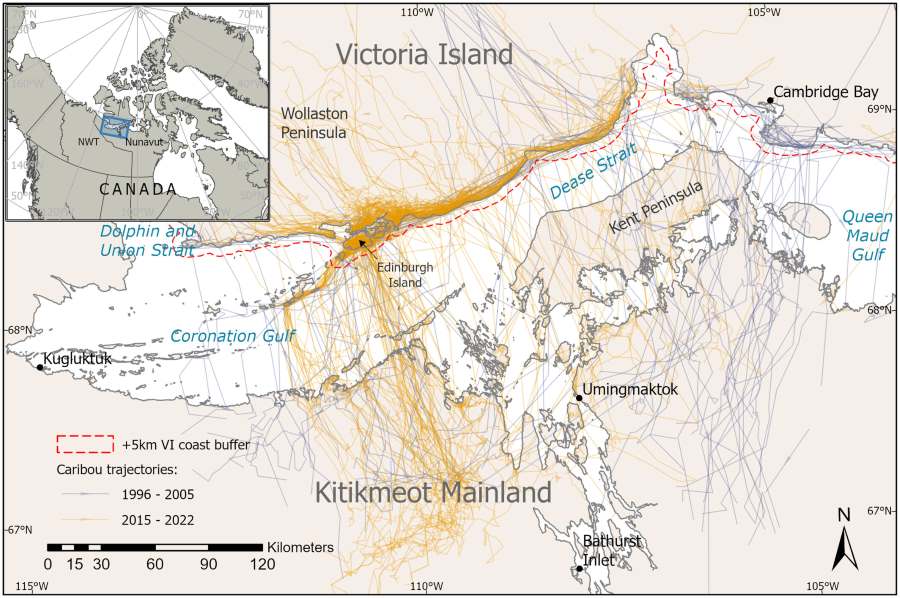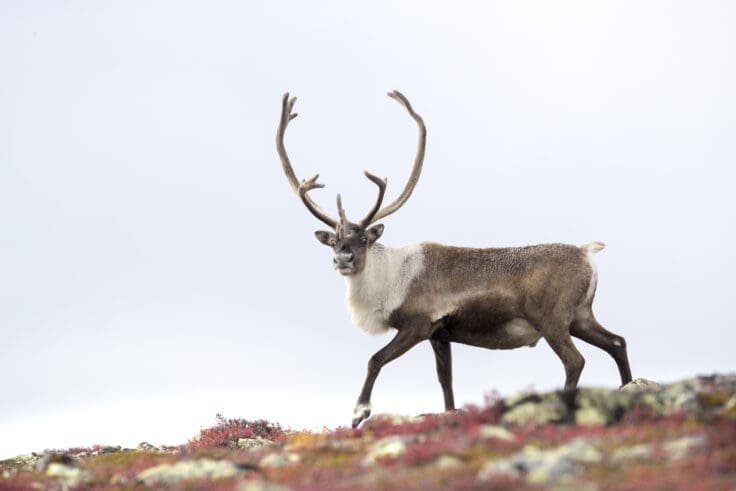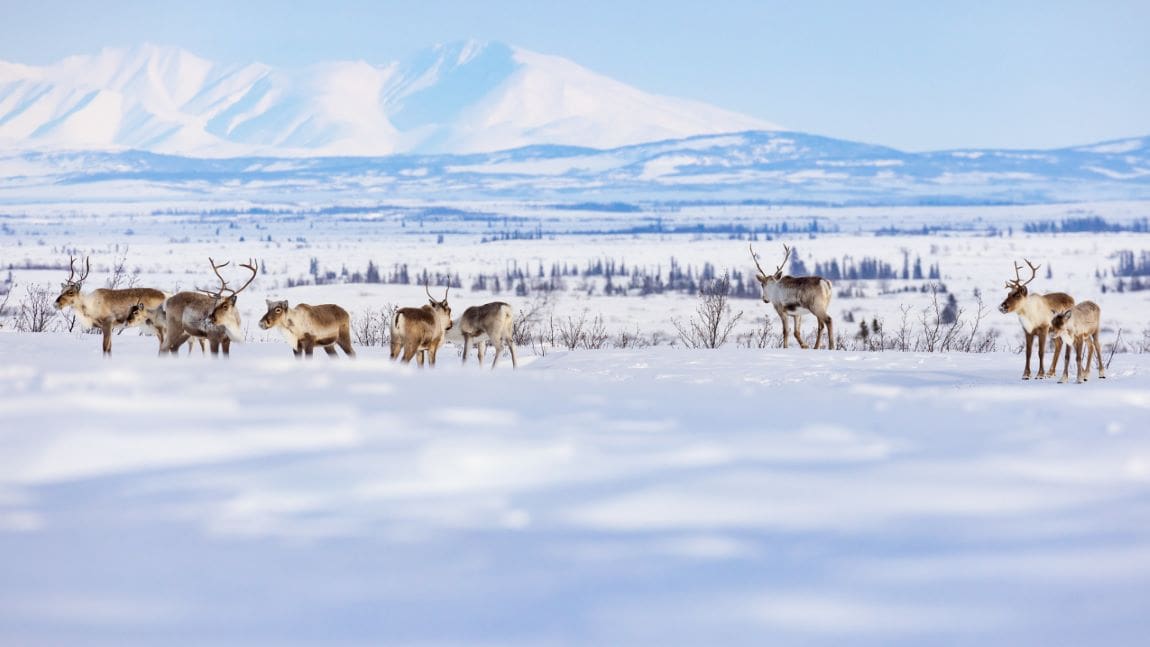Summary:
Artificial intelligence is now helping to protect endangered caribou in the Canadian Arctic, where seasonal sea ice plays a critical role in their migration. A new study published in Ecological Solutions and Evidence describes how researchers from the British Antarctic Survey, The Alan Turing Institute, WWF, and the Government of Nunavut developed a forecasting tool that uses AI to predict when sea ice conditions will support migration. By combining satellite telemetry data, GPS tracking, and local knowledge, the system gives early warnings of when Dolphin and Union caribou are likely to begin their southward crossing over newly formed sea ice.
These caribou migrate twice a year between Victoria Island and mainland Canada, relying on fragile sea ice corridors that are increasingly threatened by climate change and shipping. Ice-breaking vessels can create open water at critical times, blocking migration routes and increasing mortality. The AI model, adapted from an existing forecasting tool known as IceNet, can help local agencies decide when to limit ice-breaking activity to reduce disruption. The researchers say the system could also be adapted to support conservation planning for other Arctic species, including polar bears and walrus, as part of broader efforts to manage a region undergoing rapid environmental change.

New AI tool aids caribou conservation in a changing Arctic
The research led by British Antarctic Survey (BAS) scientists demonstrates how this technology could assist local agencies in protecting critical migration routes which cross areas of land and sea ice.
The technology could help prevent ice-breaking vessels from disrupting these routes at key moments in the migration of caribou, ensuring they can safely travel south across areas of sea ice from their summer calving grounds.
The study combines satellite observations, GPS tracking, AI forecasting, and local expertise to create AI-informed migration early-warning systems for Dolphin and Union caribou (Rangifer tarandus groenlandicus x pearyi).

Dr Ellen Bowler, a machine learning research scientist at BAS and lead author of the study, explained: “Many Arctic animals’ life histories and movement patterns are intrinsically linked to sea ice, which grows and retreats with the seasons. Climate change is causing Arctic sea ice to recede and become less stable – which also means the region is becoming more accessible for ships. This combination of threats could have fatal consequences for iconic animals like caribou.
“This new technique combines our AI sea-ice forecasts with historic tracking data from the caribou, so we can predict when they are likely to start migrating based on when the sea ice forms. This means that local teams can take short-term action to support the migration by protecting sea ice migration routes from ice-breaking vessels. It’s exciting that AI could give such a positive real-world outcome.”
Dolphin and Union caribou migrate twice a year across sea ice which forms seasonally in the waterways between mainland Canada and Victoria Island. This transit sees the caribou gather on the banks of Victoria Island every autumn, waiting for sea ice to reform before they can migrate back south. They begin crossing once sufficient ice has formed, which varies annually.
Unfortunately, increasing numbers of caribou perish during these crossings due to lower sea ice quality, and ice-breaking vessels which pose a further threat by creating open-water leads, potentially blocking crucial migration routes. Local organisations are exploring how they can mitigate shipping impacts to protect the herd, which are vital to the lives and livelihoods of local Inuit and Inuvialuit people.
The authors developed a model combining caribou tracking data and satellite observations of sea ice to establish connections between sea ice formation and the timing of the autumn migration. The AI then forecasts when sea ice conditions triggering the autumn migration will be met, to give early-warnings of peak migration times which can be updated on an annual basis.
This ecological research builds on an existing machine learning model, IceNet, a probabilistic model shown to accurately predict sea ice extents up to three months in advance. IceNet is trained on satellite-derived observations and outperforms state-of-the-art traditional models, including in seasonal forecasts of summer sea ice. Developed by BAS and The Alan Turing Institute, IceNet is also set to aid navigation by the British Antarctic Survey research ship RRS Sir David Attenborough.
The information provided by the AI model can support local agencies in making more informed and dynamic decisions – such as when and where to recommend short-term limits on ice-breaking activity by nearby ships. The AI model’s development and operation benefit greatly from invaluable local knowledge.
Dr Scott Hosking, co-author and Mission Director for Environmental Forecasting at The Alan Turing Institute added: “The Arctic is warming at four times the rate of the rest of the planet, resulting in rapid changes. In the hands of local conservation experts, and combined with their existing knowledge and practices, this tool could help mitigate the threats posed to wildlife and communities in the Arctic.”
The team is working to explore applications for other Arctic species, including iconic species such as polar bears and walrus. This could include predicting when polar bears are most likely to arrive on land near to communities, to mitigate against human-polar bear conflict.
Dr Rod Downie, Chief Polar Advisor Polar & Oceans, for WWF-UK, said: “Arctic wildlife including caribou are facing the full force of the climate crisis. The change that we are witnessing today will result in a very different Arctic than the one we have been used to. But every fraction of a degree matters. We need to urgently tackle the climate crisis and we need to plan for change so that people and nature can continue to thrive. AI-based conservation tools will have a role in helping us to achieve that.”
Journal Reference:
Bowler, E., Byrne, J., Leclerc, L.-M., Roberto-Charron, A., Rogers, M. S. J., Cavanagh, R. D., Harasimo, J., Lancaster, M. L., Chan, R. S. Y., Strickson, O., Wilkinson, J., Downie, R., Hosking, J. S., & Andersson, T. R., ‘AI sea ice forecasts for Arctic conservation: A case study predicting the timing of caribou sea ice migrations’, Ecological Solutions and Evidence 6, e70034 (2025). DOI: 10.1002/2688-8319.70034
Article Source:
Press Release/Material by British Antarctic Survey (BAS)
Featured image: A group caribou from the Western Arctic Caribou Herd travels along a winter trail between the villages of Selawik and Ambler, Alaska, within the Selawik National Wildlife Refuge. The herd migrates through and sometimes winters on the refuge. Credit: Lisa Hupp | USFWS | Public Domain




